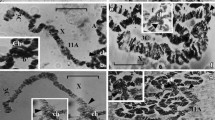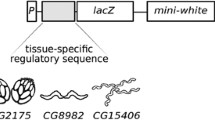Summary
The phenotype of the variegation position effect white-mottled-2 in Drosophila hydei is modified by supernumerary Y chromosomes and by fractions thereof. Different translocated Y fragments have varying degrees of effectiveness in suppressing the mutant phenotype in the mottled eyes. In fragments derived from similar regions of the Y chromosome the suppressive ability is related to their cytological lengths. In contrast, fragments derived from distinctive regions of the Y chromosome differ markedly in their effectiveness, and these differences are not necessarily correlated with the cytological length. In particular, fragments of the distal region of YL are more effective in enhancing the wild phenotype than are proximal fragments of similar size.
The mutation white-mottled-2 is accompanied by a complex rearrangement of the X chromosome. This inhibits crossing over between large regions of the X chromosome in structural heterozygotes; it causes also a delay of development and a considerable reduction of viability in homozygous females and hemizygous males. XO males are inviable. The inviability of these males is partially covered by Y fragments. With respect to viability, the fragments show similar regional differences in effectiveness as in the modification of the mottled phenotype.
There is also a parental effect on the modulation of the white-mottled-2 phenotype.
There is no correlation between the activity of Y chromosomal factors on spermiogenesis and the activity of Y factors on the modification of the variegation position effect. Suppression of Y chromosomal sites which normally unfold lampbrush loops during the spermatocyte stage and whose activity has previously been shown to be indispensible for normal differentiation of the male germ line cells does not result in any visible alterations of the effectiveness on the mottling. So there is obviously independence between these two different genetic activities of Y chromosomal factors.
Similar content being viewed by others
References
Baker, W. K.: Position-effect variegation. Advanc. Genet. 14, 133–169 (1968).
— Rein, H.: The dichotomous action of Y chromosomes on the expression of position-effect variegation. Genetics 47, 1399–1407 (1962).
Beermann, W.: Differentiation at the level of the chromosomes. In: Cell differentiation and morphogenesis, p. 24–54. Amsterdam: North Holland Publ. Co. 1966.
Beermann, W.: Gen-Regulation in Chromosomen höherer Organismen. Jb. Max Planck-Ges., 69–87 (1966).
Berendes, H. D.: The salivary gland chromosomes of Drosophila hydei Sturtevant. Chromosoma (Berl.) 14, 195–206 (1963).
Berlowitz, L.: Analysis of histone in situ in developmentally inactivated chromatin. Proc. nat. Acad. Sci. (Wash.) 54, 476–480 (1965).
Britten, R. J., Davidson, E. H.: Gene regulation for higher cells: A theory. Science 165, 349–357 (1969).
Brosseau, G.: Genetic analysis of the male fertility factors on the Y chromosome of Drosophila melanogaster. Genetics 45, 257–274 (1960).
—: Evidence that heterochromatin does not suppress V-type position effect. Genetics 50, 237 (1964).
Cooper, K. W.: Phenotypic effect of Y chromosome hyperploidy in Drosophila melanogaster, and their relation to variegation. Genetics 41, 242–264 (1956).
Gloor, H., Breugel, F. M. A. van, Volkers, W. S.: Some observations on variegation in Drosophila. Genetica 38, 95–114 (1967).
Gowen, J. W., Gay, E. H.: Eversporting as a function of the Y chromosome in Drosophila melanogaster. Proc. nat. Acad. Sci. (Wash.) 19, 122–126 (1933).
Hess, O.: Die Mutation “scute-8” von Drosophila melanogaster als ein Letalfaktor, dessen Penetranz vom Heterochromatin abhängt. Verhandl. Dtsch. Zool. Ges., Zool. Anz., Suppl. 26, 87–92 (1963).
—: Struktur-Differenzierungen im Y-Chromosom von Drosophila hydei und ihre Beziehungen zu Gen-Aktivitäten. III. Sequenz und Lokalisation der Schleifen-Bildungsorte. Chromosoma (Berl.) 16, 222–248 (1965).
—: Complementation of genetic activity in translocated fragments of the Y chromosome in Drosophila hydei. Genetics 56, 283–295 (1967).
—: The function of the lampbrush loops formed by the Y chromosome of Drosophila hydei in spermatocyte nuclei. Molec. Gen. Genetics 103, 58–71 (1968).
—: Genetic function correlated with unfolding of lampbrush loops by the Y chromosome in spermatocytes of Drosophila hydei. Molec. Gen. Genetics 106, 328–346 (1970).
— Green, M. M.: Report of new mutants of Drosophila hydei. Dros. Inf. Service 40, 37–39 (1965).
— Meyer, G. F.: Chromosomal differentiations of the lampbrush type formed by the Y chromosome in Drosophila hydei. J. Cell Biol. 16, 527–539 (1963).
—: Genetic activities of the Y chromosome in Drosophila during spermatogenesis. Advanc. Genet. 14, 171–223 (1968).
Himes, M.: An analysis of heterochromatin in maize root tips. J. Cell Biol. 35, 175–181 (1967).
Lewis, E. B.: The phenomenon of position effect. Advanc. Genet. 3, 73–115 (1950).
Lindsley, D. L., Edington, C. W., Halle, E. S. v.: Sex-linked recessive lethals in Drosophila whose expression is suppressed by the Y-chromosome. Genetics 45, 1649–1670 (1960).
Loewus, M. W., Brown, S. W.: Base ratios of DNA in male and female Pseudococcus citri. Nature (Lond.) 203, 104 (1964).
Mather, K.: The genetical activity of heterochromatin. Proc. roy. Soc. B 132, 308–332 (1944).
Mukherjee, A. S.: Cytological localization of the white locus in Drosophila hydei. Dros. Inf. Service 40, 70 (1965).
Noujdin, N. I.: The regularities of heterochromatin influence on mosaicism. J. gen. Biol. (USSR) 5, 357–388 (1944).
Perreault, W. J., Kaufmann, B. P., Gay, H.: Similarity in base composition of heterochromatic and euchromatic DNA in Drosophila melanogaster. Genetics 60, 289–301 (1968).
Rudkin, G. T.: The structure and function of heterochromatin. Genetics today, vol. 2, p. 359–374. London: Pergamon Press 1965.
Schultz, J.: Variegation in Drosophila and the inert chromosome regions. Proc. nat. Acad. Sci. (Wash.) 22, 27–33 (1936).
—: The nature of heterochromatin. Cold Spr. Harb. Symp. quant. Biol. 12, 179–191 (1947).
Spencer, W. P.: Gene homologies and the mutants of Drosophila hydei. In: G. L. Jepsen, E. Mayr, G. G. Simpson (edits.), Genetics, paleontology, and evolution, p. 23–44. Princeton, N. J.: Princeton Univ. Press 1949.
Spofford, J. B.: Parental control of position-effect variegation. I. Parental heterochromatin and expression of the white locus in compound-X Drosophila melanogaster. Proc. nat. Acad. Sci. (Wash.) 45, 1003–1007 (1959).
—: Parental control of position-effect variegation. II. Effect of parent contributing white-mottled rearrangement in Drosophila melanogaster. Genetics 46, 1151–1168 (1961).
Author information
Authors and Affiliations
Additional information
Communicated by G. Melchers
Rights and permissions
About this article
Cite this article
Hess, O. Independence between modification of genetic position effects and formation of lampbrush loops by the Y chromosome of Drosophila hydei . Molec. Gen. Genet. 107, 224–242 (1970). https://doi.org/10.1007/BF00268697
Received:
Issue Date:
DOI: https://doi.org/10.1007/BF00268697




